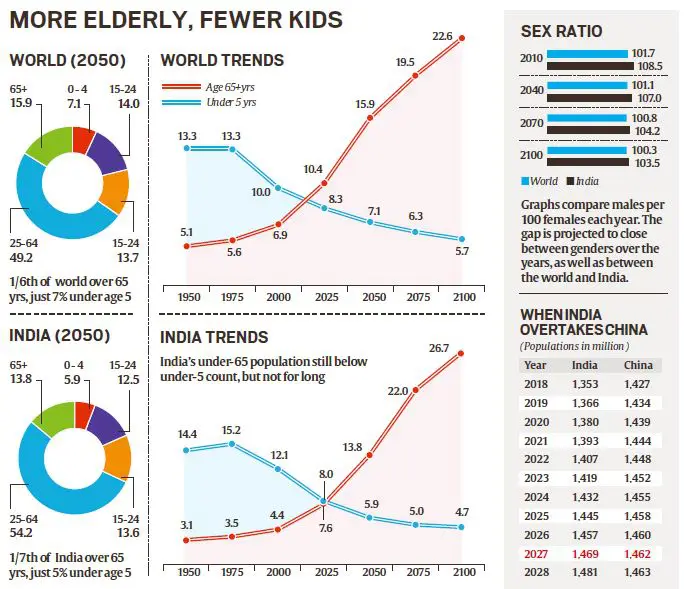World Population Projections 2019 Report published by UN | UPSC – IAS
World population – The report projects the world population to reach some 9.7 billion by 2050. However, it says that the overall growth rate will continue to fall. The next 30 years will see the population add 2 billion people to today’s 7.7 billion. The world population will reach 11 billion by the end of the century. Half of the projected increase in the global population up to 2050 will be concentrated in just 9 countries. This is led by India and followed by Nigeria, Pakistan, Democratic Republic of the Congo, Ethiopia, Tanzania, Indonesia, Egypt and the US. Many of the fastest growing populations are in the poorest countries. Here, population growth brings additional challenges in the form of poverty, equality, hunger and malnutrition, low education, etc.
Major highlights | UPSC – IAS
- Fertility rates–The fertility rates are falling worldwide.
- The average number of births per woman globally, from 3.2 in 1990, fell to 2.5 by 2019.
- This is now projected to fall further to 2.2 births by 2050.
- To avoid decline in a national population, a fertility level of 2.1 births per woman is necessary (in the absence of immigration).
- Age composition – In 2018, for the first time, persons aged 65 years or over worldwide outnumbered children under age five.
- Projections indicate that by 2050, there will be more than twice as many persons above 65 as children under five.
- By 2050, one in six people in the world will be over age 65 (16%), up from one in 11 in 2019 (9%).
- By 2050, the number of persons aged 65 or over will also surpass the number of adolescents and youth aged 15-24.
- The number of persons aged 80 years or over is projected to triple, from 143 million in 2019 to 426 million in 2050.
- Life expectancy – The overall life expectancy will increase from 64.2 years in 1990 to 77.1 years in 2050.
- However, life expectancy in poorer countries is projected to continue to lag behind.
- Today, the average lifespan of a baby born in one of the least developed countries will be some 7 years shorter than one born in a developed country.
- The main reasons cited are high child and maternal mortality rates, conflict and insecurity, and the continuing impact of the HIV epidemic.
- Dwindling populations – The populations of 55 countries are projected to decrease by 1% or more between 2019 and 2050.
- The largest relative reductions in population size (loss of around 20% or more) over this period are expected in Bulgaria, Latvia, Lithuania, Ukraine, and the Wallis and Futuna Islands.
- The key reasons are sustained low levels of fertility, and, in some places, high rates of emigration.
- Migration – Migration flows have become a major reason for population change in certain regions.
- Bangladesh, Nepal and the Philippines are seeing the largest migratory outflows resulting from the demand for migrant workers.
- Myanmar, Syria and Venezuela are the countries where the largest numbers are leaving because of insecurity or conflict.
- Sex ratio – Males are projected to continue to outnumber females until the end of the century, but the gap will close eventually.
India’s population | UPSC – IAS
- China, with 1.43 billion people in 2019, and India, with 1.37 billion, have long been the two most populous countries of the world.
- China and India comprise 19 and 18%, respectively, of the global total population in 2019. They are followed by the USA.
- India is projected to surpass China as the world’s most populous country in the next 8 years i.e. by around 2027.
- India is expected to add nearly 273 million people between 2019 and 2050.
- It will remain the most populated country through the end of the current century.
- Together, the population of India and Nigeria (projected to grow by 200 million) could account for 23% of the global population increase to 2050.
- Over-65 population – In India, children under age five still outnumber the over-65 population.
- But the over-65 population is projected to overtake the under-five group between 2025 and 2030.
- By 2050, persons over age 65 will make up about one-seventh of India’s population.
- By then, the 15-24 years age group in India (13.8%), too, will outnumber the over-65 group (13.6%).
- So, children under age five are projected to constitute less than 6% of India’s population in 2050, as compared to 7% globally.





